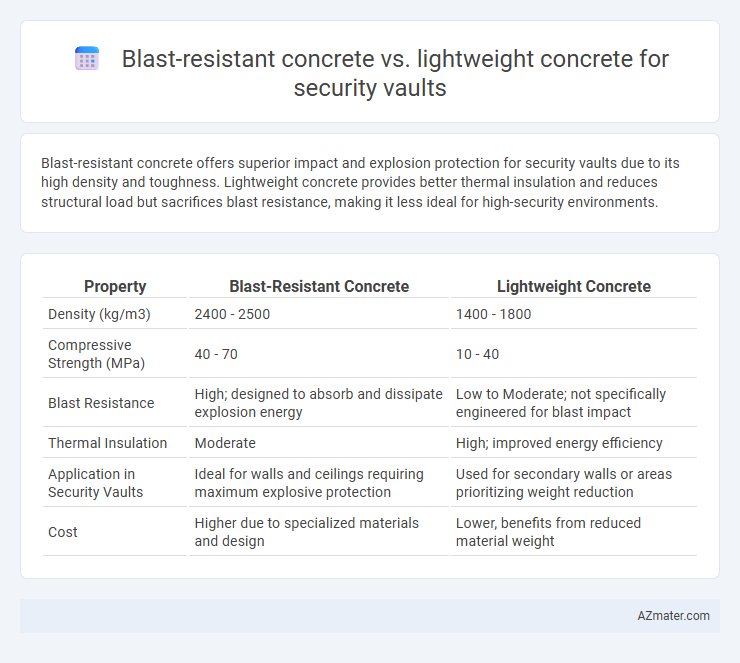Blast-resistant concrete offers superior impact and explosion protection for security vaults due to its high density and toughness. Lightweight concrete provides better thermal insulation and reduces structural load but sacrifices blast resistance, making it less ideal for high-security environments.
Table of Comparison
| Property | Blast-Resistant Concrete | Lightweight Concrete |
|---|---|---|
| Density (kg/m3) | 2400 - 2500 | 1400 - 1800 |
| Compressive Strength (MPa) | 40 - 70 | 10 - 40 |
| Blast Resistance | High; designed to absorb and dissipate explosion energy | Low to Moderate; not specifically engineered for blast impact |
| Thermal Insulation | Moderate | High; improved energy efficiency |
| Application in Security Vaults | Ideal for walls and ceilings requiring maximum explosive protection | Used for secondary walls or areas prioritizing weight reduction |
| Cost | Higher due to specialized materials and design | Lower, benefits from reduced material weight |
Introduction to Security Vault Concrete Requirements
Security vault concrete must prioritize high compressive strength, blast resistance, and impact absorption to withstand explosions and forceful attacks. Blast-resistant concrete incorporates heavy aggregates and fiber reinforcements to dissipate shock waves, whereas lightweight concrete emphasizes reduced density for easier structural integration without compromising security. Selecting the appropriate concrete type depends on balancing protection, weight constraints, and structural design requirements specific to vault security standards.
Understanding Blast-Resistant Concrete
Blast-resistant concrete for security vaults is engineered with high-strength aggregates, fibers, and specialized admixtures to absorb and dissipate explosive energy, significantly enhancing structural integrity under blast pressures. Its dense composition provides superior resistance to shock waves and fragmentation compared to lightweight concrete, which prioritizes reduced weight over blast mitigation. Understanding the material properties, such as compressive strength exceeding 10,000 psi and energy absorption capacity, is crucial for designing vaults that withstand explosive attacks and protect valuable assets.
Overview of Lightweight Concrete
Lightweight concrete for security vaults offers enhanced energy absorption and reduced structural load compared to traditional blast-resistant concrete, making it ideal for applications requiring both protection and weight efficiency. This type of concrete typically incorporates expanded clay, shale, or pumice aggregates, which contribute to improved thermal insulation and fire resistance without compromising strength. Lightweight concrete's balance of durability and weight savings enhances vault design flexibility while maintaining essential security and blast mitigation properties.
Structural Performance Comparison
Blast-resistant concrete offers superior structural performance in security vaults by providing high density and enhanced energy absorption, effectively mitigating shockwaves from explosions. Lightweight concrete, while easier to handle and reducing overall building weight, typically has lower compressive strength and less impact resistance, which may compromise blast resilience. For critical security vaults, blast-resistant concrete ensures optimal protection by maintaining structural integrity under extreme pressure, whereas lightweight concrete is better suited for applications where weight reduction is prioritized over maximum blast resistance.
Blast Resistance Capabilities
Blast-resistant concrete for security vaults features high-density aggregates and specialized admixtures to absorb and dissipate explosive forces effectively, providing superior protection against high-pressure shock waves. Lightweight concrete, while beneficial for reducing structural loads, typically lacks the mass and compressive strength necessary to withstand significant blast impacts, making it less suitable for high-security vault applications. Optimizing blast resistance requires materials with inherent toughness and energy absorption capacity, characteristics more pronounced in blast-resistant concrete formulations.
Weight and Load Considerations
Blast-resistant concrete for security vaults offers high density and mass crucial for absorbing explosive forces but significantly increases structural load due to its heavyweight composition, often exceeding 2400 kg/m3. Lightweight concrete, typically weighing between 1400-1800 kg/m3, reduces dead load on supporting structures, allowing greater design flexibility and cost-effective reinforcement in vault construction while providing moderate blast resistance. Balancing the enhanced protective qualities of blast-resistant concrete against the structural advantages of lightweight concrete is essential for optimized security vault design under strict weight and load constraints.
Installation and Construction Challenges
Blast-resistant concrete requires specialized mixing and placement techniques to achieve high compressive strength and energy absorption, often necessitating skilled labor and longer curing times. Lightweight concrete poses challenges in maintaining structural integrity and insulation without compromising load-bearing capacity, demanding precise material selection and compaction methods. Both materials require careful consideration of reinforcement integration and site conditions to ensure optimal performance in security vault construction.
Cost Implications and Budgeting
Blast-resistant concrete typically incurs higher costs due to specialized materials and reinforcement techniques essential for withstanding explosive forces in security vault construction. Lightweight concrete offers budget advantages by reducing structural load and material expenses but may require additional layers or treatments to achieve comparable security standards. Careful cost-benefit analysis considering project-specific threat levels and long-term maintenance is crucial for effective budgeting in security vault design.
Longevity and Durability Assessment
Blast-resistant concrete offers superior longevity and durability for security vaults due to its high compressive strength, enhanced fiber reinforcement, and optimized aggregate composition that effectively absorb and dissipate explosive forces. Lightweight concrete, while beneficial for reducing structural load, generally exhibits lower density and strength, which can compromise its long-term resilience against blast impacts and sustained stress. Assessments indicate that blast-resistant concrete ensures prolonged structural integrity and enhanced protection, making it the preferred choice for high-security applications requiring rigorous durability standards.
Best Applications: Choosing the Optimal Solution for Security Vaults
Blast-resistant concrete offers superior protection against explosions and high-impact forces, making it ideal for security vaults requiring maximum defense against violent attacks and explosive threats. Lightweight concrete provides enhanced thermal insulation and ease of installation, suitable for vaults where weight reduction and energy efficiency are priorities without compromising basic security. Selecting the optimal solution depends on balancing structural demands, threat levels, and operational requirements specific to the security vault environment.

Infographic: Blast-resistant concrete vs Lightweight concrete for Security vault
 azmater.com
azmater.com